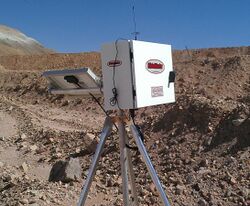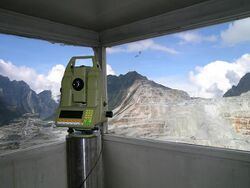Physics:Deformation monitoring
Deformation monitoring (also referred to as deformation survey) is the systematic measurement and tracking of the alteration in the shape or dimensions of an object as a result of stresses induced by applied loads. Deformation monitoring is a major component of logging measured values that may be used for further computation, deformation analysis, predictive maintenance, and alarming.[1]
Deformation monitoring is primarily associated with the field of applied surveying but may also be relevant to civil engineering, mechanical engineering, construction, and geology. The measurement devices utilized for deformation monitoring depend on the application, the chosen method, and the preferred measurement interval.
Measuring devices
Measuring devices (or sensors) can be sorted in two main groups: geodetic and geotechnical sensors. Both measuring devices can be seamlessly combined in modern deformation monitoring.
- Geodetic measuring devices measure georeferenced (relative to established locations outside the monitoring area) displacements or movements in one, two or three dimensions. It includes the use of instruments such as total stations, levels, InSAR,[2] and global navigation satellite system receivers.
- Geotechnical measuring devices measure displacements or movements and related environmental effects or conditions without external georeferencing. It includes the use of instruments such as extensometers,[3] piezometers, pressuremeters, rain gauges, thermometers, barometers, tiltmeters,[4] accelerometers, seismometers, etc.
Application
Deformation monitoring can be required for the following applications:
- Dams[5]
- Roads
- Tunnels
- Bridges and Viaducts
- High-rise and historical buildings[6]
- Foundations
- Construction sites
- Mining[7]
- Landslide areas[8]
- Volcanoes
- Settlement areas
- Earthquake areas
Methods

Deformation monitoring can be manual or automatic. Manual deformation monitoring is the operation of sensors or instruments by hand or manual downloading of collected data from deformation monitoring instruments. Automatic deformation monitoring operation of a group of software and hardware elements for deformation monitoring that, once set up, does not require human input to function.
Note that deformation analysis and interpretation of the data collected by the monitoring system is not included in this definition.
Automated deformation monitoring requires instruments to communicate with a base station. Communication methods used include:
- Transmission cable (RS-232, RS-485, fiber optics)
- Local area network (LAN)
- Wireless LAN (WLAN)
- Mobile communication (GSM, GPRS, UMTS)
- WiMax
Regularity and scheduling
The monitoring regularity and time interval of the measurements must be considered depending on the application and object to be monitored. Objects can undergo both rapid, high frequency movement and slow, gradual movement. For example, a bridge might oscillates with a period of a few seconds due to the influence of traffic and wind and also be shifting gradually due to tectonic changes.
- Regularity: ranges from a days, weeks or years for manual monitoring and continuous for automatic monitoring systems.
- Measurement interval: ranges from fractions of a second to hours.
Deformation analysis
Deformation analysis is concerned with determining if a measured displacement is significant enough to warrant a response. Deformation data must be checked for statistical significance, and then checked against specified limits, and reviewed to see if movements below specified limits imply potential risks.
The software acquires data from sensors, computes meaningful values from the measurements, records results, and can notify responsible persons should threshold value be exceeded. However, a human operator must make considered decisions on the appropriate response to the movement, e.g. independent verification though on-site inspections, re-active controls such as structural repairs and emergency responses such as shut down processes, containment processes and site evacuation.
See also
- Engineering Geology
- Slope stability
- Slope stability radar
- Structural health monitoring
References
- ↑ Literature, Edited by J.F.A Moore (1992). Monitoring Building Structures. Blackie and Son Ltd. ISBN:0-216-93141-X, USA and Canada ISBN:0-442-31333-0
- ↑ Dai, Keren; Li, Zhenhong; Tomás, Roberto; Liu, Guoxiang; Yu, Bing; Wang, Xiaowen; Cheng, Haiqin; Chen, Jiajun et al. (December 2016). "Monitoring activity at the Daguangbao mega-landslide (China) using Sentinel-1 TOPS time series interferometry". Remote Sensing of Environment 186: 501–513. doi:10.1016/j.rse.2016.09.009. ISSN 0034-4257. Bibcode: 2016RSEnv.186..501D.
- ↑ Pardo, Juan Manuel; Lozano, Antonio; Herrera, Gerardo; Mulas, Joaquín; Rodríguez, Ángel (2013-09-15). "Instrumental monitoring of the subsidence due to groundwater withdrawal in the city of Murcia (Spain)" (in en). Environmental Earth Sciences 70 (5): 1957–1963. doi:10.1007/s12665-013-2710-7. ISSN 1866-6280. Bibcode: 2013EES....70.1957P.
- ↑ Díaz, E.; Robles, P.; Tomás, R. (October 2018). "Multitechnical approach for damage assessment and reinforcement of buildings located on subsiding areas: Study case of a 7-story RC building in Murcia (SE Spain)". Engineering Structures 173: 744–757. doi:10.1016/j.engstruct.2018.07.031. ISSN 0141-0296. Bibcode: 2018EngSt.173..744D.
- ↑ Tomás, R.; Cano, M.; García-Barba, J.; Vicente, F.; Herrera, G.; Lopez-Sanchez, J.M.; Mallorquí, J.J. (May 2013). "Monitoring an earthfill dam using differential SAR interferometry: La Pedrera dam, Alicante, Spain". Engineering Geology 157: 21–32. doi:10.1016/j.enggeo.2013.01.022. ISSN 0013-7952. Bibcode: 2013EngGe.157...21T.
- ↑ Tomás, Roberto; García-Barba, Javier; Cano, Miguel; Sanabria, Margarita P; Ivorra, Salvador; Duro, Javier; Herrera, Gerardo (November 2012). "Subsidence damage assessment of a Gothic church using differential interferometry and field data". Structural Health Monitoring 11 (6): 751–762. doi:10.1177/1475921712451953. ISSN 1475-9217.
- ↑ Herrera, G.; Álvarez Fernández, M.I.; Tomás, R.; González-Nicieza, C.; López-Sánchez, J.M.; Álvarez Vigil, A.E. (September 2012). "Forensic analysis of buildings affected by mining subsidence based on Differential Interferometry (Part III)". Engineering Failure Analysis 24: 67–76. doi:10.1016/j.engfailanal.2012.03.003. ISSN 1350-6307.
- ↑ Dai, Keren; Li, Zhenhong; Tomás, Roberto; Liu, Guoxiang; Yu, Bing; Wang, Xiaowen; Cheng, Haiqin; Chen, Jiajun et al. (December 2016). "Monitoring activity at the Daguangbao mega-landslide (China) using Sentinel-1 TOPS time series interferometry". Remote Sensing of Environment 186: 501–513. doi:10.1016/j.rse.2016.09.009. ISSN 0034-4257. Bibcode: 2016RSEnv.186..501D.
- ↑ "Cyclops". https://www.sixense-group.com/en/offer/monitoring/soil-structural-and-environmental-measurement/cyclops.
Further reading
- American Surveyor, Elevated Monitoring (page 6-12)
- Bozzano, Francesca; Cipriani, Ivan; Mazzanti, Paolo; Prestininzi, Alberto (2011). "Displacement patterns of a landslide affected by human activities: Insights from ground-based InSAR monitoring". Natural Hazards 59 (3): 1377. doi:10.1007/s11069-011-9840-6.
- North Americas Largest Copper Mine, Automated Mine Monitoring Integrated System
- The use of Slope Stability Radar (SSR) in managing Slope Instability Hazards, AusIMM Bulletin, January/February 2008
- Applications and Limitations of Automated Motorized Total Stations by Douglas S. Roy, P.E., M.ASCE and Pierre Gouvin, A.M.ASCE
- The American Surveyor (Oct 2007) - 24/7 Structural Monitoring
- Monitoring of Open Pit Mines using Combined GNSS Satellite Receivers and Robotic Total Stations
- Engineering Solutions with Trimble 4D Control, Trimble Survey Controller, Trimble S8 Total Station White Paper, Trimble 2007
- Advances in RTK and Post Processed Monitoring with Single Frequency GPS
- Nachweis von Turmbewegungen mit einem Multisensorsystem
- Monitoring Hong Kong's Bridges Real-Time Kinematic Spans The Gap
- FIG 2001 - Modern Monitoring System Software Development
 |




